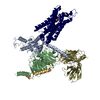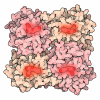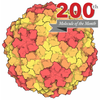+ Open data
Open data
- Basic information
Basic information
| Entry |  | |||||||||
|---|---|---|---|---|---|---|---|---|---|---|
| Title | A3R-Gi complex bound to i6A | |||||||||
 Map data Map data | ||||||||||
 Sample Sample |
| |||||||||
 Keywords Keywords | GPCR / G protein / adenosine receptor / adenosine / complex / SIGNALING PROTEIN | |||||||||
| Function / homology |  Function and homology information Function and homology informationAdenylate cyclase inhibitory pathway / Olfactory Signaling Pathway / Sensory perception of sweet, bitter, and umami (glutamate) taste / Synthesis, secretion, and inactivation of Glucagon-like Peptide-1 (GLP-1) / G protein-coupled adenosine receptor activity / Activation of the phototransduction cascade / Activation of G protein gated Potassium channels / G-protein activation / G beta:gamma signalling through PI3Kgamma / Prostacyclin signalling through prostacyclin receptor ...Adenylate cyclase inhibitory pathway / Olfactory Signaling Pathway / Sensory perception of sweet, bitter, and umami (glutamate) taste / Synthesis, secretion, and inactivation of Glucagon-like Peptide-1 (GLP-1) / G protein-coupled adenosine receptor activity / Activation of the phototransduction cascade / Activation of G protein gated Potassium channels / G-protein activation / G beta:gamma signalling through PI3Kgamma / Prostacyclin signalling through prostacyclin receptor / G beta:gamma signalling through PLC beta / ADP signalling through P2Y purinoceptor 1 / Thromboxane signalling through TP receptor / Presynaptic function of Kainate receptors / G beta:gamma signalling through CDC42 / Inhibition of voltage gated Ca2+ channels via Gbeta/gamma subunits / G alpha (12/13) signalling events / Glucagon-type ligand receptors / G beta:gamma signalling through BTK / ADP signalling through P2Y purinoceptor 12 / Adrenaline,noradrenaline inhibits insulin secretion / Cooperation of PDCL (PhLP1) and TRiC/CCT in G-protein beta folding / Ca2+ pathway / Thrombin signalling through proteinase activated receptors (PARs) / G alpha (z) signalling events / Extra-nuclear estrogen signaling / G alpha (s) signalling events / G alpha (q) signalling events / G alpha (i) signalling events / Glucagon-like Peptide-1 (GLP1) regulates insulin secretion / High laminar flow shear stress activates signaling by PIEZO1 and PECAM1:CDH5:KDR in endothelial cells / Vasopressin regulates renal water homeostasis via Aquaporins / positive regulation of protein localization to cell cortex / G protein-coupled serotonin receptor binding / cellular response to forskolin / regulation of mitotic spindle organization / bioluminescence / viral budding from plasma membrane / generation of precursor metabolites and energy / G protein-coupled receptor binding / adenylate cyclase-modulating G protein-coupled receptor signaling pathway / G-protein beta/gamma-subunit complex binding / G beta:gamma signalling through PLC beta / Presynaptic function of Kainate receptors / Thromboxane signalling through TP receptor / G-protein activation / Activation of G protein gated Potassium channels / Inhibition of voltage gated Ca2+ channels via Gbeta/gamma subunits / Prostacyclin signalling through prostacyclin receptor / G beta:gamma signalling through CDC42 / Glucagon signaling in metabolic regulation / G beta:gamma signalling through BTK / ADP signalling through P2Y purinoceptor 12 / photoreceptor disc membrane / Glucagon-type ligand receptors / Adrenaline,noradrenaline inhibits insulin secretion / Vasopressin regulates renal water homeostasis via Aquaporins / GDP binding / G alpha (z) signalling events / Glucagon-like Peptide-1 (GLP1) regulates insulin secretion / ADP signalling through P2Y purinoceptor 1 / cellular response to catecholamine stimulus / ADORA2B mediated anti-inflammatory cytokines production / G beta:gamma signalling through PI3Kgamma / Cooperation of PDCL (PhLP1) and TRiC/CCT in G-protein beta folding / adenylate cyclase-activating dopamine receptor signaling pathway / GPER1 signaling / cellular response to prostaglandin E stimulus / G-protein beta-subunit binding / heterotrimeric G-protein complex / G alpha (12/13) signalling events / sensory perception of taste / signaling receptor complex adaptor activity / Thrombin signalling through proteinase activated receptors (PARs) / retina development in camera-type eye / GTPase binding / Ca2+ pathway / midbody / fibroblast proliferation / High laminar flow shear stress activates signaling by PIEZO1 and PECAM1:CDH5:KDR in endothelial cells / cell cortex / G alpha (i) signalling events / G alpha (s) signalling events / phospholipase C-activating G protein-coupled receptor signaling pathway / clathrin-dependent endocytosis of virus by host cell / Hydrolases; Acting on acid anhydrides; Acting on GTP to facilitate cellular and subcellular movement / G alpha (q) signalling events / Extra-nuclear estrogen signaling / cell population proliferation / host cell surface receptor binding / G protein-coupled receptor signaling pathway / fusion of virus membrane with host plasma membrane / cell division / GTPase activity / fusion of virus membrane with host endosome membrane / viral envelope / dendrite / synapse / centrosome / GTP binding Similarity search - Function | |||||||||
| Biological species |      human respiratory syncytial virus human respiratory syncytial virus | |||||||||
| Method | single particle reconstruction / cryo EM / Resolution: 3.66 Å | |||||||||
 Authors Authors | Oshima HS / Shihoya W / Nureki O | |||||||||
| Funding support |  Japan, 1 items Japan, 1 items
| |||||||||
 Citation Citation |  Journal: Nat Commun / Year: 2024 Journal: Nat Commun / Year: 2024Title: Structural insights into the agonist selectivity of the adenosine A receptor. Authors: Hidetaka S Oshima / Akiko Ogawa / Fumiya K Sano / Hiroaki Akasaka / Tomoyoshi Kawakami / Aika Iwama / Hiroyuki H Okamoto / Chisae Nagiri / Fan-Yan Wei / Wataru Shihoya / Osamu Nureki /  Abstract: Adenosine receptors play pivotal roles in physiological processes. Adenosine A receptor (AR), the most recently identified adenosine receptor, is expressed in various tissues, exhibiting important ...Adenosine receptors play pivotal roles in physiological processes. Adenosine A receptor (AR), the most recently identified adenosine receptor, is expressed in various tissues, exhibiting important roles in neuron, heart, and immune cells, and is often overexpressed in tumors, highlighting the therapeutic potential of AR-selective agents. Recently, we identified RNA-derived N-methyladenosine (mA) as an endogenous agonist for AR, suggesting the relationship between RNA-derived modified adenosine and AR. Despite extensive studies on the other adenosine receptors, the selectivity mechanism of AR, especially for AR-selective agonists such as mA and namodenoson, remained elusive. Here, we identify tRNA-derived N-isopentenyl adenosine (iA) as an AR-selective ligand via screening of modified nucleosides against the adenosine receptors. Like mA, iA is found in the human body and may be an endogenous AR ligand. Our cryo-EM analyses elucidate the AR-G complexes bound to adenosine, 5'-N-ethylcarboxamidoadenosine (NECA), mA, iA, and namodenoson at overall resolutions of 3.27 Å (adenosine), 2.86 Å (NECA), 3.19 Å (mA), 3.28 Å (iA), and 3.20 Å (namodenoson), suggesting the selectivity and activation mechanism of AR. We further conduct structure-guided engineering of mA-insensitive AR, which may aid future research targeting mA and AR, providing a molecular basis for future drug discovery. | |||||||||
| History |
|
- Structure visualization
Structure visualization
| Supplemental images |
|---|
- Downloads & links
Downloads & links
-EMDB archive
| Map data |  emd_39281.map.gz emd_39281.map.gz | 17.1 MB |  EMDB map data format EMDB map data format | |
|---|---|---|---|---|
| Header (meta data) |  emd-39281-v30.xml emd-39281-v30.xml emd-39281.xml emd-39281.xml | 17.1 KB 17.1 KB | Display Display |  EMDB header EMDB header |
| Images |  emd_39281.png emd_39281.png | 27.2 KB | ||
| Filedesc metadata |  emd-39281.cif.gz emd-39281.cif.gz | 7.5 KB | ||
| Archive directory |  http://ftp.pdbj.org/pub/emdb/structures/EMD-39281 http://ftp.pdbj.org/pub/emdb/structures/EMD-39281 ftp://ftp.pdbj.org/pub/emdb/structures/EMD-39281 ftp://ftp.pdbj.org/pub/emdb/structures/EMD-39281 | HTTPS FTP |
-Validation report
| Summary document |  emd_39281_validation.pdf.gz emd_39281_validation.pdf.gz | 430.2 KB | Display |  EMDB validaton report EMDB validaton report |
|---|---|---|---|---|
| Full document |  emd_39281_full_validation.pdf.gz emd_39281_full_validation.pdf.gz | 429.8 KB | Display | |
| Data in XML |  emd_39281_validation.xml.gz emd_39281_validation.xml.gz | 6 KB | Display | |
| Data in CIF |  emd_39281_validation.cif.gz emd_39281_validation.cif.gz | 7 KB | Display | |
| Arichive directory |  https://ftp.pdbj.org/pub/emdb/validation_reports/EMD-39281 https://ftp.pdbj.org/pub/emdb/validation_reports/EMD-39281 ftp://ftp.pdbj.org/pub/emdb/validation_reports/EMD-39281 ftp://ftp.pdbj.org/pub/emdb/validation_reports/EMD-39281 | HTTPS FTP |
-Related structure data
| Related structure data |  8yh5MC  8yh0C  8yh2C  8yh3C  8yh6C C: citing same article ( M: atomic model generated by this map |
|---|---|
| Similar structure data | Similarity search - Function & homology  F&H Search F&H Search |
- Links
Links
| EMDB pages |  EMDB (EBI/PDBe) / EMDB (EBI/PDBe) /  EMDataResource EMDataResource |
|---|---|
| Related items in Molecule of the Month |
- Map
Map
| File |  Download / File: emd_39281.map.gz / Format: CCP4 / Size: 35.3 MB / Type: IMAGE STORED AS FLOATING POINT NUMBER (4 BYTES) Download / File: emd_39281.map.gz / Format: CCP4 / Size: 35.3 MB / Type: IMAGE STORED AS FLOATING POINT NUMBER (4 BYTES) | ||||||||||||||||||||||||||||||||||||
|---|---|---|---|---|---|---|---|---|---|---|---|---|---|---|---|---|---|---|---|---|---|---|---|---|---|---|---|---|---|---|---|---|---|---|---|---|---|
| Projections & slices | Image control
Images are generated by Spider. | ||||||||||||||||||||||||||||||||||||
| Voxel size | X=Y=Z: 1.11 Å | ||||||||||||||||||||||||||||||||||||
| Density |
| ||||||||||||||||||||||||||||||||||||
| Symmetry | Space group: 1 | ||||||||||||||||||||||||||||||||||||
| Details | EMDB XML:
|
-Supplemental data
- Sample components
Sample components
-Entire : A3R-Gi complex bound to i6a
| Entire | Name: A3R-Gi complex bound to i6a |
|---|---|
| Components |
|
-Supramolecule #1: A3R-Gi complex bound to i6a
| Supramolecule | Name: A3R-Gi complex bound to i6a / type: complex / ID: 1 / Parent: 0 / Macromolecule list: #1-#2, #4, #3 |
|---|---|
| Source (natural) | Organism:  |
-Macromolecule #1: Guanine nucleotide-binding protein G(I)/G(S)/G(T) subunit beta-1
| Macromolecule | Name: Guanine nucleotide-binding protein G(I)/G(S)/G(T) subunit beta-1 type: protein_or_peptide / ID: 1 / Number of copies: 1 / Enantiomer: LEVO |
|---|---|
| Source (natural) | Organism:  |
| Molecular weight | Theoretical: 40.586332 KDa |
| Recombinant expression | Organism:  Homo sapiens (human) Homo sapiens (human) |
| Sequence | String: MGSLLQSELD QLRQEAEQLK NQIRDARKAC ADATLSQITN NIDPVGRIQM RTRRTLRGHL AKIYAMHWGT DSRLLVSASQ DGKLIIWDS YTTNKVHAIP LRSSWVMTCA YAPSGNYVAC GGLDNICSIY NLKTREGNVR VSRELAGHTG YLSCCRFLDD N QIVTSSGD ...String: MGSLLQSELD QLRQEAEQLK NQIRDARKAC ADATLSQITN NIDPVGRIQM RTRRTLRGHL AKIYAMHWGT DSRLLVSASQ DGKLIIWDS YTTNKVHAIP LRSSWVMTCA YAPSGNYVAC GGLDNICSIY NLKTREGNVR VSRELAGHTG YLSCCRFLDD N QIVTSSGD TTCALWDIET GQQTTTFTGH TGDVMSLSLA PDTRLFVSGA CDASAKLWDV REGMCRQTFT GHESDINAIC FF PNGNAFA TGSDDATCRL FDLRADQELM TYSHDNIICG ITSVSFSKSG RLLLAGYDDF NCNVWDALKA DRAGVLAGHD NRV SCLGVT DDGMAVATGS WDSFLKIWNG ASGGGSGGNS GSSGGSSGVS GWRLFKKIS UniProtKB: Guanine nucleotide-binding protein G(I)/G(S)/G(T) subunit beta-1 |
-Macromolecule #2: Guanine nucleotide-binding protein G(I)/G(S)/G(O) subunit gamma-2...
| Macromolecule | Name: Guanine nucleotide-binding protein G(I)/G(S)/G(O) subunit gamma-2,Guanine nucleotide-binding protein G(i) subunit alpha-1 chimera type: protein_or_peptide / ID: 2 / Number of copies: 2 / Enantiomer: LEVO |
|---|---|
| Source (natural) | Organism:  |
| Molecular weight | Theoretical: 48.846695 KDa |
| Recombinant expression | Organism:  Homo sapiens (human) Homo sapiens (human) |
| Sequence | String: MASNNTASIA QARKLVEQLK MEANIDRIKV SKAAADLMAY CEAHAKEDPL LTPVPASENP FREKKFFCAI LGSAGSAGSA MCTLSAEDK AAVERSKMID RNLREDGEKA AREVKLLLLG AGESGKSTIV KQMKIIHEAG YSEEECKQYK AVVYSNTIQS I IAIIRAMG ...String: MASNNTASIA QARKLVEQLK MEANIDRIKV SKAAADLMAY CEAHAKEDPL LTPVPASENP FREKKFFCAI LGSAGSAGSA MCTLSAEDK AAVERSKMID RNLREDGEKA AREVKLLLLG AGESGKSTIV KQMKIIHEAG YSEEECKQYK AVVYSNTIQS I IAIIRAMG RLKIDFGDSA RADDARQLFV LAGAAEEGFM TAELAGVIKR LWKDSGVQAC FNRSREYQLN DSAAYYLNDL DR IAQPNYI PTQQDVLRTR VKTTGIVETH FTFKDLHFKM FDVGGQRSER KKWIHCFEGV TAIIFCVALS DYDLVLAEDE EMN RMHESM KLFDSICNNK WFTDTSIILF LNKKDLFEEK IKKSPLTICY PEYAGSNTYE EAAAYIQCQF EDLNKRKDTK EIYT HFTCA TDTKNVQFVF DAVTDVIIKN NLKDCGLF UniProtKB: Guanine nucleotide-binding protein G(I)/G(S)/G(O) subunit gamma-2, Guanine nucleotide-binding protein G(i) subunit alpha-1 |
-Macromolecule #3: scfv16
| Macromolecule | Name: scfv16 / type: protein_or_peptide / ID: 3 / Number of copies: 1 / Enantiomer: LEVO |
|---|---|
| Source (natural) | Organism:  |
| Molecular weight | Theoretical: 27.720795 KDa |
| Recombinant expression | Organism:  Homo sapiens (human) Homo sapiens (human) |
| Sequence | String: DVQLVESGGG LVQPGGSRKL SCSASGFAFS SFGMHWVRQA PEKGLEWVAY ISSGSGTIYY ADTVKGRFTI SRDDPKNTLF LQMTSLRSE DTAMYYCVRS IYYYGSSPFD FWGQGTTLTV SSGGGGSGGG GSGGGGSDIV MTQATSSVPV TPGESVSISC R SSKSLLHS ...String: DVQLVESGGG LVQPGGSRKL SCSASGFAFS SFGMHWVRQA PEKGLEWVAY ISSGSGTIYY ADTVKGRFTI SRDDPKNTLF LQMTSLRSE DTAMYYCVRS IYYYGSSPFD FWGQGTTLTV SSGGGGSGGG GSGGGGSDIV MTQATSSVPV TPGESVSISC R SSKSLLHS NGNTYLYWFL QRPGQSPQLL IYRMSNLASG VPDRFSGSGS GTAFTLTISR LEAEDVGVYY CMQHLEYPLT FG AGTKLEL KAAAASSEDL YFQ |
-Macromolecule #4: Hemagglutinin,Adenosine receptor A3,GFP chimera
| Macromolecule | Name: Hemagglutinin,Adenosine receptor A3,GFP chimera / type: protein_or_peptide / ID: 4 / Number of copies: 1 / Enantiomer: LEVO |
|---|---|
| Source (natural) | Organism:  human respiratory syncytial virus human respiratory syncytial virus |
| Molecular weight | Theoretical: 88.315891 KDa |
| Recombinant expression | Organism:  Homo sapiens (human) Homo sapiens (human) |
| Sequence | String: MKTIIALSYI FCLVFADYKD DDDAMGPVNS TAVSWTSVTY ITVEILIGLC AIVGNVLVIW VVKLNPSLQT TTFYFIVSLA LADIAVGVL VMPLAIVISL GVTIHFYSCL FMTCLMLIFT HASIMSLLAI AVDRYLRVKL TVRYRRVTTQ RRIWLALGLC W LVSFLVGL ...String: MKTIIALSYI FCLVFADYKD DDDAMGPVNS TAVSWTSVTY ITVEILIGLC AIVGNVLVIW VVKLNPSLQT TTFYFIVSLA LADIAVGVL VMPLAIVISL GVTIHFYSCL FMTCLMLIFT HASIMSLLAI AVDRYLRVKL TVRYRRVTTQ RRIWLALGLC W LVSFLVGL TPMFGWNMKL SSADENLTFL PCRFRSVMRM DYMVYFSFFL WILVPLVVMC AIYFDIFYII RNRLSQSFSG SR ETGAFYG REFKTAKSLL LVLFLFALCW LPLSIINCIL YFDGQVPQTV LYLGILLSHA NSMMNPIVYA YKIKKFKETY LLI LKACVI CQPSKSMDPS TEQTSEGSGG GGSGGSSSGG VFTLEDFVGD WEQTAAYNLD QVLEQGGVSS LLQNLAVSVT PIQR IVRSG ENALKIDIHV IIPYEGLSAD QMAQIEEVFK VVYPVDDHHF KVILPYGTLV IDGVTPNMLN YFGRPYEGIA VFDGK KITV TGTLWNGNKI IDERLITPDG SMLFRVTINS GGSGGGGSGG SSSGGLEVLF QGPGSAAAAV SKGEELFTGV VPILVE LDG DVNGHKFSVS GEGEGDATYG KLTLKFICTT GKLPVPWPTL VTTLTYGVQC FSRYPDHMKQ HDFFKSAMPE GYVQERT IF FKDDGNYKTR AEVKFEGDTL VNRIELKGID FKEDGNILGH KLEYNYNSHN VYIMADKQKN GIKVNFKIRH NIEDGSVQ L ADHYQQNTPI GDGPVLLPDN HYLSTQSKLS KDPNEKRDHM VLLEFVTAAG ITLGMDELYK SGLRSHHHHH HHH UniProtKB: Hemagglutinin, Adenosine receptor A3, GFP |
-Macromolecule #5: N-(3-methylbut-2-en-1-yl)adenosine
| Macromolecule | Name: N-(3-methylbut-2-en-1-yl)adenosine / type: ligand / ID: 5 / Number of copies: 1 / Formula: ZIR |
|---|---|
| Molecular weight | Theoretical: 335.358 Da |
| Chemical component information |  ChemComp-ZIR: |
-Experimental details
-Structure determination
| Method | cryo EM |
|---|---|
 Processing Processing | single particle reconstruction |
| Aggregation state | particle |
- Sample preparation
Sample preparation
| Buffer | pH: 8 |
|---|---|
| Vitrification | Cryogen name: ETHANE |
- Electron microscopy
Electron microscopy
| Microscope | FEI TITAN KRIOS |
|---|---|
| Image recording | Film or detector model: GATAN K3 (6k x 4k) / Average electron dose: 50.0 e/Å2 |
| Electron beam | Acceleration voltage: 300 kV / Electron source:  FIELD EMISSION GUN FIELD EMISSION GUN |
| Electron optics | Illumination mode: FLOOD BEAM / Imaging mode: BRIGHT FIELD / Nominal defocus max: 1.6 µm / Nominal defocus min: 0.8 µm |
| Experimental equipment |  Model: Titan Krios / Image courtesy: FEI Company |
 Movie
Movie Controller
Controller












































 X (Sec.)
X (Sec.) Y (Row.)
Y (Row.) Z (Col.)
Z (Col.)




















